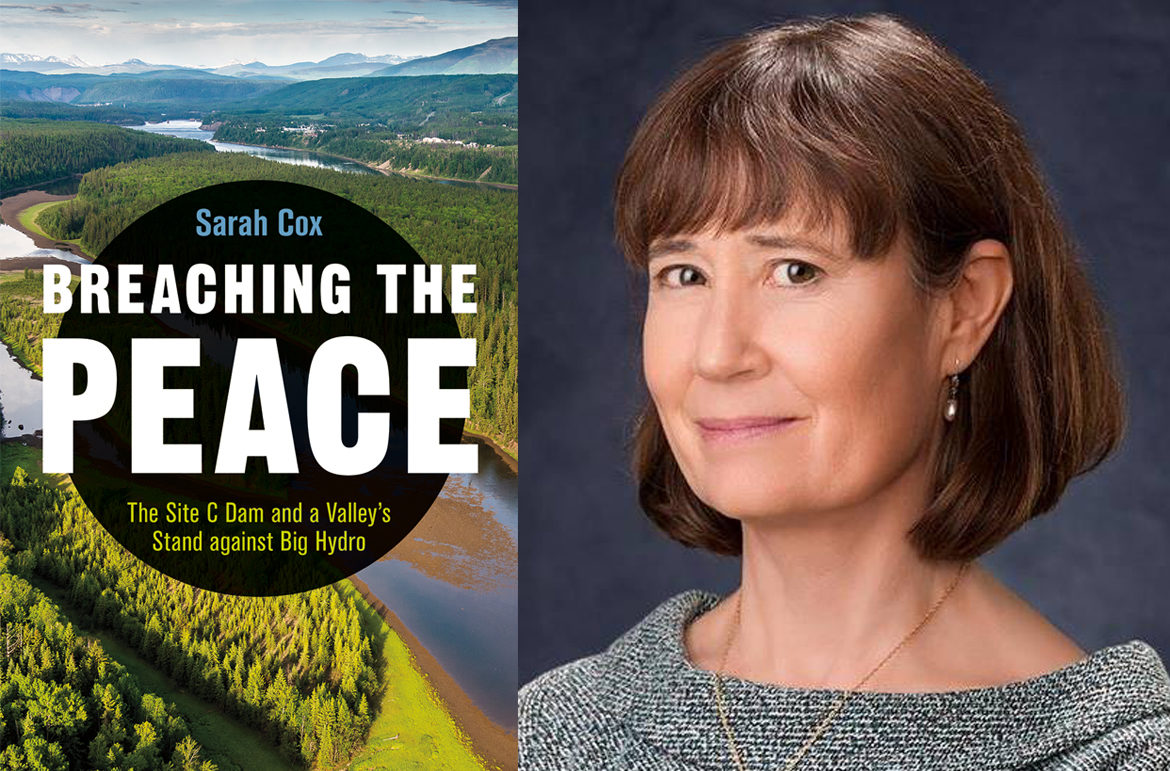Listening to the news, it’s hard not to hear about the massive 1,100 megawatt hydro dam proposed for the Peace River. Christy Clark and the BC Liberals have been pushing for the project for years, and much to the dismay of many British Columbians, the BC NDP approved it in December 2017. Award-winning journalist Sarah Cox breaks down the controversial Site C Dam project in her new book, Breaching the Peace: The Site C Dam and a Valley’s Stand against Big Hydro (UBC Press).
The Site C project is not environmentally friendly
The Site C dam will flood 128 kilometres of the heritage Peace River and its tributaries, about the equivalent distance of driving from Victoria to Nanaimo or Vancouver to Whistler. It will destroy 450 protected archaeological and heritage sites and more than 12,000 hectares of some of Canada’s richest farmland. It will also eradicate habitat for more than 100 species vulnerable to extinction, including bird and butterfly species and the rare Peace daisy, found nowhere else in the world.
According to 200 of Canada’s leading scholars, the Site C dam will have more adverse environmental effects than any project ever examined in the history of Canada’s environmental assessment act. The scholars compared Site C to projects such as the Enbridge Northern Gateway pipeline, scuttled by the federal government on the grounds that it would be too harmful to the environment and First Nations. The Northern Gateway project had one adverse environmental effect; Site C had 20.
BC does not need Site C’s power
Power demand has been flat in BC since 2005 even though the population has climbed. We have so much power that BC Hydro pays independent power producers millions of dollars a year not to produce electricity. BC Hydro has also slashed the budget for energy conservation programs and now proposes to change the rules so that people who install solar panels can no longer sell excess power to the grid.
Even if the electrification of BC requires additional power, a combination of wind, solar, and geothermal energy can generate more clean power than Site C and come online far faster. Alberta just bought new wind power for $37 per megawatt hour; Site C’s power will cost $120 per megawatt hour. BC has no buyer for Site C’s power. The electricity will be sold on the spot market at far less than it costs to produce, leaving BC Hydro customers to make up the difference.
Site C violates human rights
Site C violates commitments by Canada and BC to uphold the United Nations Declaration on the Rights of Indigenous Peoples. Grand Chief Stewart Phillip, president of the Union of BC Indian Chiefs, called the BC government’s December decision to proceed with Site C an “absolute outrage” because construction is continuing without the free, prior, and informed consent of First Nations. Several Treaty 8 First Nations are fighting Site C in court, saying that it violates their constitutionally protected rights. The global human rights organization Amnesty International has made stopping Site C a priority campaign, noting the “irreversible and irreparable human cost” of the project for First Nations, farmers and Peace River Valley families.
BC Families cannot afford Site C
In two other Canadian provinces where large dams are under construction, hydro customers face soaring bills. Each household in Newfoundland and Labrador will pay an average $1,800 more in annual hydro bills because of the over-budget Muskrat Falls dam. Manitoba Hydro recently asked for permission to raise provincial hydro rates by a compounded rate of 8% a year for six years to help pay for the over-budget Keeyask dam project. Only two years into nine years of construction, Site C’s initial price tag of $8.8 billion jumped by another $2 billion in the fall of 2017, to the tune of $10.7 billion. According to a review by the watchdog BC Utilities Commission — now stripped of its power to oversee Site C expenditures — the project’s final price tag could exceed $12.5 billion. Current hydro bills do not reflect Site C’s costs.
It’s not too late to stop Site C
Graham Lane, the former head of Manitoba’s Public Utilities Board, is among a growing chorus of voices calling for an immediate halt to construction of the Keeyask dam on the Nelson River in Manitoba. Keeyask has incurred $4 to $4.5 billion in sunk costs, compared to just over $2 billion for the Site C dam. In Lane’s words, “it’s never too late to stop.”
Sarah Cox is an award-winning journalist who specializes in energy and environmental issues. Her work has appeared in numerous magazines, online publications, and provincial and national newspapers.
Breaching the Peace: The Site C Dam and a Valley’s Stand against Big Hydro (UBC Press), is Sarah’s first book and tells the inspiring and astonishing story of the farmers and First Nations who fought the most expensive megaproject in BC history and the government-sanctioned bullying that propelled it forward. She lives in Victoria, British Columbia.
Sarah will be holding launch events for Breaching the Peace in Victoria on May 1, Vancouver on May 3, and Sechelt on May 6.

